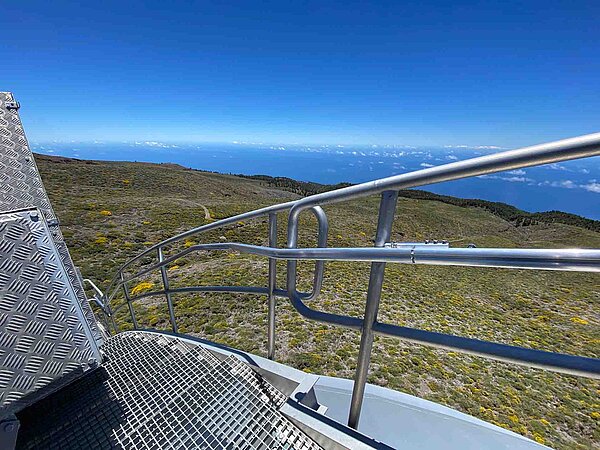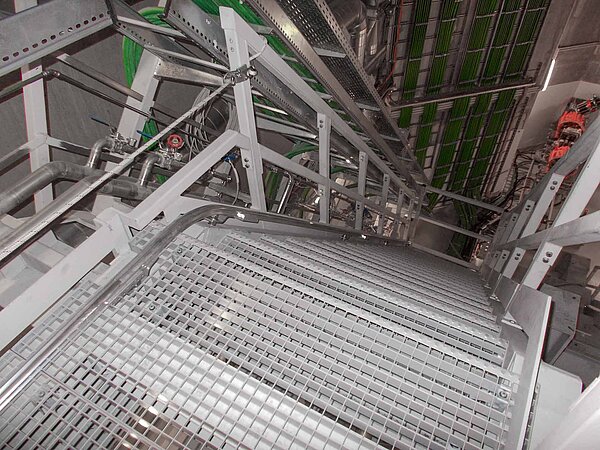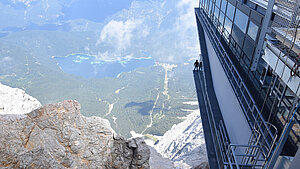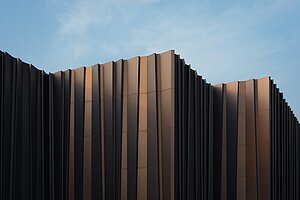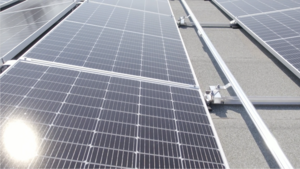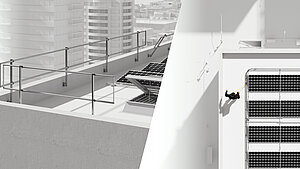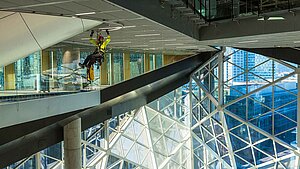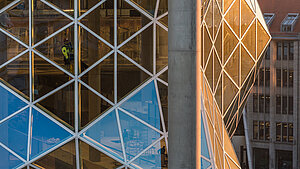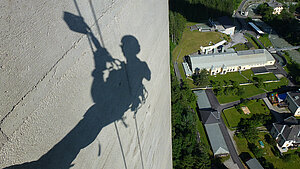This post explains how transitions and subsequent fall risk areas can be protected. For this, an application example clarifies the implementation of protected transitions. Continuous fall protection plays an important role in providing people with danger-free access to surfaces at height and to their working area.
What is a transition?
A transition is a structure, installed on a roof for example, by means of which it is possible to climb over obstacles like pipes, cabling, non-supporting surfaces, or roof openings - or even over a parapet. This makes it possible for people who must perform work on the roof or roofs to access and leave them safely. Here, one solution is to use a fixed transition - e.g. permanently installed steps, with or without a platform.
Transitions are also used in an industrial context, for example to move from one platform to others. Access routes to machinery or other types of working area are also implemented using transitions. Steps are used to transition from ground level to machinery or platforms at height.
The purpose of a transition is to ensure the safety of those who have to work on the roof or in the area at height. Installing a transition avoids potential obstacles and stumble hazards which can arise if there is no suitable option for access. A transition creates clear access paths and safe access.
As a rule, a transition must be equipped with suitable fall protection in order to minimise the risk of falls.
Why does a transition have to be protected?
A transition must be protected because this is required by industrial protection regulations in order to ensure the safety of employees. A risk assessment complying with the applicable legal requirements and taking the fall height into account specifies the fall protection measures which must be taken. Even for fall heights less than 2 metres, a fall protection system may be necessary, for example when a machine has to be operated.
Transitions can be equipped with guardrails, thus providing the necessary protection. However, this has to be assessed by an expert on the basis of the individual circumstances. If the transition is followed by a clear fall risk area close to a fall edge, then the transition’s guardrail or fall protection at the side is insufficient. Continuous fall protection must be ensured.
Depending on the surroundings and working conditions, collective fall protection or an individual protection solution has to be installed. In this case, industrial requirements can be quite specific. Especially for access routes from the ground via several flights of steps, platforms, and transitions up to the working area, one of the most user-friendly solutions is guided protection: A continuous rail system requires no detaching/re-attaching of the PPE.

TAURUS-ALLROUND
Rail system for all-round use
The TAURUS ALLROUND rail system combines the application range and benefits of TAURUS HORIZONTAL and VERTICAL in the form of a flowing transition between horizontal and vertical movement. Regardless whether industrial buildings, architecturally ...
Application example for a protected transition
Transition to the roof is a significant activity requiring safety measures, and these can be implemented in various working areas. Whether for maintenance of solar systems, repair work on building facades, or cleaning roof surfaces – protected transition to a roof allows workers safe and efficient access to areas at height. In addition, protected transitions to working areas can also be used for industrial machinery or for research facilities, for example. In all these application examples, the transition and personal protection during the transition are of great importance for prevention of industrial accidents and optimisation of the work process.
Using a transition with fall protection ensures that falls are prevented or that the consequences of a fall are minimised, and that workers can therefore perform their tasks in safety.
Parapet transition
A parapet transition refers to crossing or passing along a parapet which runs along the edges of a roof or building. When protected, these transitions allow safe access to areas at height on the roof or along the parapet, whether for maintenance work, inspections, or other necessary activities.
Special safety measures are required for the use of a parapet transition, because it is generally located close to fall risk areas. It is therefore essential that fall protection systems are installed, in order to ensure the appropriate protection from falls.
For safe access along the parapet (via a parapet transition), a continuous rail system like TAURUS ALLROUND is an optimum solution. Such a system allows its users to move along the rail by attaching the PPE to the slider once only, with no further need to detach/re-attach it again. The rail system is designed in such a way that it provides maximum safety to users, especially in areas where there are different height levels, but also on horizontal curves or bends.
Thus, for example, a single safety system protects the user the whole way from the ground, via steps, and finally over a parapet transition onto the roof – and even on the roof itself. By attaching to the TAURUS rail system, the workers remain protected throughout all their movements, and they can move freely without leaving the safety system.
